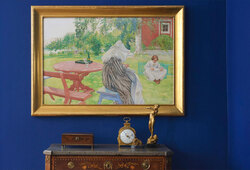Carl Milles
"Dödsängeln" (Angel of Death)
Bronzed and gilded plaster. Height 66 cm, width 45 cm.
Conceived in 1921 for Skogskapellet (the Woodland Chapel) at Skogskyrkogården (the Woodland Cemetery) in Stockholm. The present plaster model comes from architect Gunnar Asplund's private collection, and probably came into his possession in connection with the work on the Woodland Chapel.
Insignificant scratches and stains, minor paint loss, one leg with a repair, superficial hairline crack approximately 3 cm on one wing.
Provenance
Architect Gunnar Asplund (1885-1940).
Thence by descent to his son, architect Hans Asplund (1921-1994).
Thence by descent to his son, diplomat and UN ambassador Bo Asplund (1950-2024).
Thence by descent to the present owner.
Literature
Erik Näslund, "Carl Milles - En biografi", Wiken 1991, p. 200.
More information
Above the entrance to Skogskapellet (the Woodland Chapel) at Skogskyrkogården (the Woodland Cemetery) in southern Stockholm, we find the sculptor Carl Milles' only collaboration with the architect Gunnar Asplund. The hovering "Angel of Death" has a shape unusually kind and welcoming for a servant of death. The original, which was installed in 1921, is made of hammered copper plate after a plaster model and was chased by John Färngren. Today, the original copper piece is located in the Music Room at Millesgården in Stockholm. The present plaster version is a prototype from architect Gunnar Asplund's private collection, and probably came into his possession in connection with the work on the Woodland Chapel.
In April 1921, the Swedish art historian Nils G. Wollin wrote in an issue of the Swedish Society of Crafts and Design journal about the "Angel of Death":
"Even before one has passed through the gate of the enclosure, the angel shines upon the wanderer and shows the way to the dwelling where the dead are consecrated to eternity. In the solitude of the forest, the luminous figure appears as a revelation. Like a child of the imagination with which we first read about these heavenly messengers. With its rich material character of indestructible substance, the angel here represents the transcendent world from which it comes, while the chapel, in its restrained simplicity, constructed solely of painted wood, signifies humanity's earthly transience. Yet, despite this contrast in material choice, the angel beautifully blends into the surroundings, as the chapel is ennobled by the harmonious proportions that are the hallmark of true architecture. [...] This angel of death must, in my opinion, be counted among the most consummate within this genre of sculpture that we possess."
Artist
Carl Milles was a Swedish sculptor born in Lägga. He studied at the Technical School in Stockholm, at the Ecole des Beaux-Arts in Paris under Auguste Rodin and on study trips to Germany, the Netherlands and Belgium. In Paris he came to stay for many years and made a living as an ornament carver. He studied the animals in the Jardin des Plantes (the Zoological Garden) and was strongly influenced by Auguste Rodin. Milles made a breakthrough with a monument to Sten Sture in Uppsala. He exhibited at the World's Fair in 1900 and was later given a solo exhibition at the Tate Gallery in London. Milles was professor of modeling at the Royal Academy of Arts in Stockholm. Well-known sculptures in public places signed by Carl Milles are the "Gustav Vasa" statue at the Nordic Museum, "Orfeusgruppen" outside the concert hall in Stockholm and the "Poseidonfontänen" in Gothenburg.
Read more












































